You are using an out of date browser. It may not display this or other websites correctly.
You should upgrade or use an alternative browser.
You should upgrade or use an alternative browser.
Not a Moment to Lose… Battle of the Bulge, Ardennes, December 1944
- Thread starter TIM FORSTER
- Start date
TIM FORSTER
SMF Supporter
Thanks Paul. Sorry if progress is a bit slow at times, but I'm getting a wriggle on!Very fine work Tim. I love the building, the detailing on the 250 and… well, everything about this. This is going to be a very special diorama. Can’t wait to see the progress.
ATB
Paul
TIM FORSTER
SMF Supporter
Thanks Jakko.Very impressive already
TIM FORSTER
SMF Supporter
Avoiding a lop-sided house
One problem that only emerged once I had started putting the walls together was how to level the building within the base. This may sound obvious, but given the sharp slope I had chosen for the terrain, once the structure was in place it looked a little lop-sided. In the old days, when I built everything up from a flat base, this would not have been an issue: I simply made sure everything was flat with the base. But by digging down into the insulation board I felt that I had lost my bearings.
I used a spirit level and realised that my balsa base for the building was actually a little out of true. So how to fix it? After a lot of head-scratching I came up with the answer: wooden chopsticks.
I held one up to the rear corner of the house and measured where it met the top edge. Then I measured the height of the wall and marked the bottom edge on the stick. I then knew that this should be the correct distance between the lower edge of the base and the bottom of the building. Next I cut three chopsticks to the same length and simply pushed them into the insulation board until they met the bottom. These became the supports for the other three corners of the building. Does that make sense? Anyway, it worked.
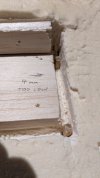
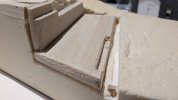
Problem solved...
One problem that only emerged once I had started putting the walls together was how to level the building within the base. This may sound obvious, but given the sharp slope I had chosen for the terrain, once the structure was in place it looked a little lop-sided. In the old days, when I built everything up from a flat base, this would not have been an issue: I simply made sure everything was flat with the base. But by digging down into the insulation board I felt that I had lost my bearings.
I used a spirit level and realised that my balsa base for the building was actually a little out of true. So how to fix it? After a lot of head-scratching I came up with the answer: wooden chopsticks.
I held one up to the rear corner of the house and measured where it met the top edge. Then I measured the height of the wall and marked the bottom edge on the stick. I then knew that this should be the correct distance between the lower edge of the base and the bottom of the building. Next I cut three chopsticks to the same length and simply pushed them into the insulation board until they met the bottom. These became the supports for the other three corners of the building. Does that make sense? Anyway, it worked.


Problem solved...
TIM FORSTER
SMF Supporter
Anyway, I should have said Happy New Year to all.
Although it was busy in our house over Christmas, I did find time to actually make some progress.
Raising the roof
I guess if you are building a REAL house then putting the roof on is always going to be the crowning achievement…
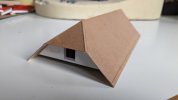
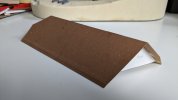
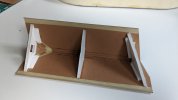
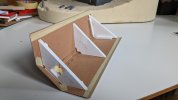
Because I had already made a roof out of rough card I was able to use this as a template for what came next: so I cut similar pieces out of slightly thinner (but better quality) card stock. I still wasn’t sure how much overhang I should have at the sides - and I needed to allow for the guttering as well - so I cut the sheets deliberately wider at first, then trimmed them. I still wasn’t happy with the look, so I hedged my bets, reattached the trimmed off pieces with masking tape and cut them again. This way I could play around with how the roof looked until I was ready to add the tiles. I also used triangles of foam board to strengthen the structure internally. This means that the entire roof can be easily removed for the next stage: adding the chimney and roof tiles.
In the shots below I have used balsa wood to mock up the position and shape of the chimney.
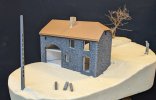
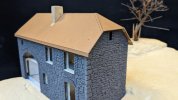
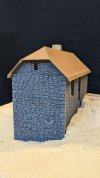
My research has been a mixture of looking at contemporary photos from the conflict and comparing these with modern images from Google streetview or Youtube documentaries. One really useful source has been:
https://www.youtube.com/@WW2Wayfinder 2
This guy posts some really informative and non-sensational videos of the Then and Now variety, with many focussed on the Ardennes battles. If you look at the background in many of his videos you can see many fascinating details, not only of the men and vehicles, but also the buildings in the areas where the fighting took place.
It was here that I saw the familiar chimneys that were prevelant on many houses. Even if the structures themselves were mostly made of stone, the chimney stacks themselves seem to have been commonly made from bricks, often off-set to one side and topped with an open cowel made from a flat plate balanced on brick supports. This design seems to make complete sense when you think of the heavy snowfall which we see in later images of the Battle of the Bulge. Looking at reference images, it also seems quite common for these combined barn / farmhouses to have a central chimney stack between each half of the structure.
So the stack was made from a thicker block of high density (XPS) styrofoam with the brick pattern cut into it in the same manner I used for the windows. This time it was especially important to line up the brick courses as I worked my way around the block to ensure that they lined up. The flat top (almost certainly asbestos cement shingles in real life - more below) was made from plastic sheet.
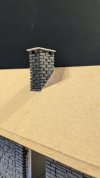
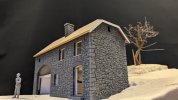
Although it was busy in our house over Christmas, I did find time to actually make some progress.
Raising the roof
I guess if you are building a REAL house then putting the roof on is always going to be the crowning achievement…




Because I had already made a roof out of rough card I was able to use this as a template for what came next: so I cut similar pieces out of slightly thinner (but better quality) card stock. I still wasn’t sure how much overhang I should have at the sides - and I needed to allow for the guttering as well - so I cut the sheets deliberately wider at first, then trimmed them. I still wasn’t happy with the look, so I hedged my bets, reattached the trimmed off pieces with masking tape and cut them again. This way I could play around with how the roof looked until I was ready to add the tiles. I also used triangles of foam board to strengthen the structure internally. This means that the entire roof can be easily removed for the next stage: adding the chimney and roof tiles.
In the shots below I have used balsa wood to mock up the position and shape of the chimney.



My research has been a mixture of looking at contemporary photos from the conflict and comparing these with modern images from Google streetview or Youtube documentaries. One really useful source has been:
https://www.youtube.com/@WW2Wayfinder 2
This guy posts some really informative and non-sensational videos of the Then and Now variety, with many focussed on the Ardennes battles. If you look at the background in many of his videos you can see many fascinating details, not only of the men and vehicles, but also the buildings in the areas where the fighting took place.
It was here that I saw the familiar chimneys that were prevelant on many houses. Even if the structures themselves were mostly made of stone, the chimney stacks themselves seem to have been commonly made from bricks, often off-set to one side and topped with an open cowel made from a flat plate balanced on brick supports. This design seems to make complete sense when you think of the heavy snowfall which we see in later images of the Battle of the Bulge. Looking at reference images, it also seems quite common for these combined barn / farmhouses to have a central chimney stack between each half of the structure.
So the stack was made from a thicker block of high density (XPS) styrofoam with the brick pattern cut into it in the same manner I used for the windows. This time it was especially important to line up the brick courses as I worked my way around the block to ensure that they lined up. The flat top (almost certainly asbestos cement shingles in real life - more below) was made from plastic sheet.


Andy the Sheep
SMF Supporter
A nice touch I previously missed: the half millstone into the side stonewall: brilliant detail! 



TIM FORSTER
SMF Supporter
I'm glad someone spotted it! I saw this in a wall in Derbyshire once and thought it would be a nice touch...A nice touch I previously missed: the half millstone into the side stonewall: brilliant detail!

TIM FORSTER
SMF Supporter
Raising the roof part 3…
[Otherwise known as tiling madness]
So diamond pattern roof tiles… I’ve learnt a lot about these of late. I started to notice them as I looked at images of the towns and villages along Peiper’s advance. By way of example, have a look at these images taken of abandoned Panthers in La Gleize after the town’s recapture.
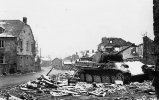
Heinz Knappich’s Panther (with tactical number ‘221’) was photographed many times from different angles. In the one above you can see the diamond pattern tiles on the roof and upper walls of the house on the left. Note also the distinctive chimney stack.
In a better quality image taken looking in the opposite direction you can see two adjacent houses with different sized of tiles, plus the familiar chimney, etc.
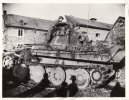
Although the image below has some quality issues, you can still see the roof tile pattern as well as many other interesting details such as a round end window, brick window surrounds and the guttering.
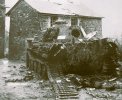
The vehicle, by the way, is panther ‘201’, formerly cammanded by Friedrich Christ and abandoned near the Aux Écuries de la Reine (Rediger Hotel).
Doing some research I found that these tiles, which are commonly known as ‘asbestos shingles’, were actually made from a mixture of asbestos, mineral fibre and cement. The asbestos ingredient helped to make them fire proof.
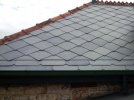
Although laid in a diamond pattern, they are actually a square tipped on one of its corners. However, in order to ensure that they overlap it is necessary to trim a little off two of the corners (or perhaps they were made this way) to allow for them to fit closer together. This diagram helps to explain:
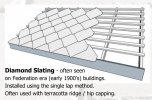
So how big should these tiles be? As we have seen, they came in different sizes. With hindsight I might have chosen a bigger option because the larger the tiles, the less you need and less work is required. However, I committed myself to a size I found on the internet which looked about right: 400 x 400mm. This works out in 1/35 as 11.42mm square. I rounded that up to 12mm and then got to work using a guillotine to cut the tiles / shingles out of black card.
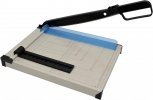
The guillotine was around £30 from Amazon. It worked very well. I tried to find a clever way to trim the corners in a uniform way, but in the end I had to just do it by hand with a pair of scissors.
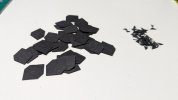
The shingles were then fixed in place with PVA applied with a brush, which gives a little more time for adjustment than UHU. I started on the rear roof (i.e. the one facing the tree) because this would be the least visible if I mucked it up. In the end, I was glad that I did. At first I started to lay the tiles in diagonal lines, but quickly discovered that it was very hard to keep the horizontal lines consistent. If you look at these roofs in real life they are actually pretty neat.
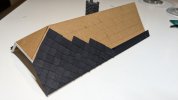
So for the other roof I worked my way along horizontally, using lines drawn on the card to help guide me straight. I was also able to cheat with the lowest row because once the row above is put in place you cannot see anything more than the triangular outline.
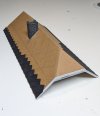
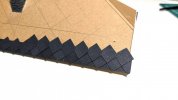
[Otherwise known as tiling madness]
So diamond pattern roof tiles… I’ve learnt a lot about these of late. I started to notice them as I looked at images of the towns and villages along Peiper’s advance. By way of example, have a look at these images taken of abandoned Panthers in La Gleize after the town’s recapture.

Heinz Knappich’s Panther (with tactical number ‘221’) was photographed many times from different angles. In the one above you can see the diamond pattern tiles on the roof and upper walls of the house on the left. Note also the distinctive chimney stack.
In a better quality image taken looking in the opposite direction you can see two adjacent houses with different sized of tiles, plus the familiar chimney, etc.

Although the image below has some quality issues, you can still see the roof tile pattern as well as many other interesting details such as a round end window, brick window surrounds and the guttering.

The vehicle, by the way, is panther ‘201’, formerly cammanded by Friedrich Christ and abandoned near the Aux Écuries de la Reine (Rediger Hotel).
Doing some research I found that these tiles, which are commonly known as ‘asbestos shingles’, were actually made from a mixture of asbestos, mineral fibre and cement. The asbestos ingredient helped to make them fire proof.

Although laid in a diamond pattern, they are actually a square tipped on one of its corners. However, in order to ensure that they overlap it is necessary to trim a little off two of the corners (or perhaps they were made this way) to allow for them to fit closer together. This diagram helps to explain:

So how big should these tiles be? As we have seen, they came in different sizes. With hindsight I might have chosen a bigger option because the larger the tiles, the less you need and less work is required. However, I committed myself to a size I found on the internet which looked about right: 400 x 400mm. This works out in 1/35 as 11.42mm square. I rounded that up to 12mm and then got to work using a guillotine to cut the tiles / shingles out of black card.

The guillotine was around £30 from Amazon. It worked very well. I tried to find a clever way to trim the corners in a uniform way, but in the end I had to just do it by hand with a pair of scissors.

The shingles were then fixed in place with PVA applied with a brush, which gives a little more time for adjustment than UHU. I started on the rear roof (i.e. the one facing the tree) because this would be the least visible if I mucked it up. In the end, I was glad that I did. At first I started to lay the tiles in diagonal lines, but quickly discovered that it was very hard to keep the horizontal lines consistent. If you look at these roofs in real life they are actually pretty neat.

So for the other roof I worked my way along horizontally, using lines drawn on the card to help guide me straight. I was also able to cheat with the lowest row because once the row above is put in place you cannot see anything more than the triangular outline.


Neil Merryweather
SMF Supporter
Brilliant!
TIM FORSTER
SMF Supporter
The tiling continues...
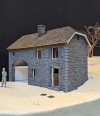
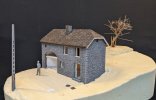
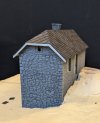
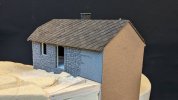
Well it was certainly a relief when I reached the last tile.
What I find interesting is the way that some of the tiles have a different shade even though they are all cut from the same piece of black card. I guess it must be the way they reflect the light. It almost seems a shame to have to paint them.
The next step was the ridge tiles.
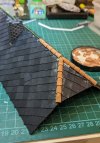
These were laid using ridge tiles that I had left over from my Italian diorama. They are cast using real terracotta and fit just like the real thing. I do have a mould to cast them myself, but it is very time-consuming and I was glad to be able to buy these ready-made a few years ago.
The best way to keep them straight and level is to lay a sausage of putty along the apex of the roof. This also helps to stick them in place, although I also added a dab of UHU beneath each tile as I worked my way along. The putty I used here was Green Stuff, which I haven't used before. I actually found it very difficult to work together and rather stiff to use.
Once they had dried in place I went back to add the cement rendering. For this I used Magic Sculp which is my favourite putty for this task. It can be easily diluted with water and worked around and beneath the tiles with a sculpting tool. It looks a bit messy here, I have to admit, but when everything is painted it should look fine.
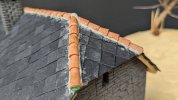
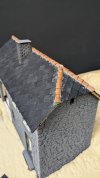
Next stop guttering and drainpipes...




Well it was certainly a relief when I reached the last tile.
What I find interesting is the way that some of the tiles have a different shade even though they are all cut from the same piece of black card. I guess it must be the way they reflect the light. It almost seems a shame to have to paint them.
The next step was the ridge tiles.

These were laid using ridge tiles that I had left over from my Italian diorama. They are cast using real terracotta and fit just like the real thing. I do have a mould to cast them myself, but it is very time-consuming and I was glad to be able to buy these ready-made a few years ago.
The best way to keep them straight and level is to lay a sausage of putty along the apex of the roof. This also helps to stick them in place, although I also added a dab of UHU beneath each tile as I worked my way along. The putty I used here was Green Stuff, which I haven't used before. I actually found it very difficult to work together and rather stiff to use.
Once they had dried in place I went back to add the cement rendering. For this I used Magic Sculp which is my favourite putty for this task. It can be easily diluted with water and worked around and beneath the tiles with a sculpting tool. It looks a bit messy here, I have to admit, but when everything is painted it should look fine.


Next stop guttering and drainpipes...
Beautiful work Tim.
scottie3158
SMF Supporter
Tim great work.
TIM FORSTER
SMF Supporter
Thanks guys.
More progress is (slowly) being made...
Building a shed
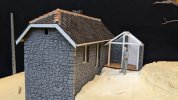
Here you can see the beginnings of the out-house that I had planned for the upper part of the diorama. This helps to create a backdrop to the broken-down jeep which is going to be positioned behind the farmhouse and just out of sight of the advancing Germans.
However, beyond establishing the general shape and size of this structure in my early cardboard cut-outs, I hadn’t thought much more about it…
So I started to construct the sort of structure that I assumed this sort of home would require. The size and shape was dictated by the angles of the base - so narrower on the right-hand side. To try and trick the eye into thinking that it had more depth, I decided to split the shed into two halves: one a workshop, the other a wood store (important in an area which obviously has heavy snow fall in Winter).
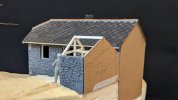
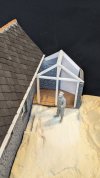
Here you can see the basic shape coming together. Although it may look odd, the rear stone wall is actually parallel to the larger building and is designed to be ‘in the shadows’ anyway. The important thing is to give the illusion that the ‘shed’ belongs to the larger structure.
I had a bit of fun with the log store. I simply used dried twigs from my garden sawn and sanded into shape - sometimes there is no substitute for the real thing - but there’s also a bit of fakery going on!
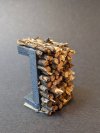
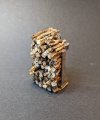
Once it's all in place I like to think it looks real enough...
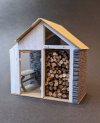
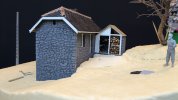
More progress is (slowly) being made...
Building a shed

Here you can see the beginnings of the out-house that I had planned for the upper part of the diorama. This helps to create a backdrop to the broken-down jeep which is going to be positioned behind the farmhouse and just out of sight of the advancing Germans.
However, beyond establishing the general shape and size of this structure in my early cardboard cut-outs, I hadn’t thought much more about it…
So I started to construct the sort of structure that I assumed this sort of home would require. The size and shape was dictated by the angles of the base - so narrower on the right-hand side. To try and trick the eye into thinking that it had more depth, I decided to split the shed into two halves: one a workshop, the other a wood store (important in an area which obviously has heavy snow fall in Winter).


Here you can see the basic shape coming together. Although it may look odd, the rear stone wall is actually parallel to the larger building and is designed to be ‘in the shadows’ anyway. The important thing is to give the illusion that the ‘shed’ belongs to the larger structure.
I had a bit of fun with the log store. I simply used dried twigs from my garden sawn and sanded into shape - sometimes there is no substitute for the real thing - but there’s also a bit of fakery going on!


Once it's all in place I like to think it looks real enough...


TIM FORSTER
SMF Supporter
Thanks. I suppose it does look like mancave of sorts. I'm going to fill it with plenty of junk to give some visual appeal... so a classic man cave then!For a moment I thought the owner also had a man cave for his hobby...nice addition.
Cheers,
Wabble
